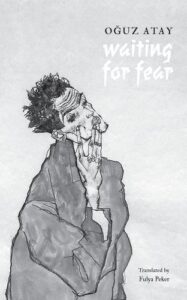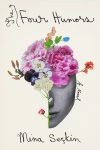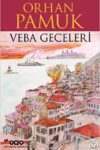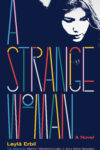
[Contra Mundum Press; 2022]
Tr. from the Turkish by Fulya Peker
In “Railroad Storytellers — A Dream,” Oğuz Atay’s narrator admits that all he knows how to do is write stories, that even the illusion of starting a new life is forever beyond his reach. Atay finished this piece, the last short story he ever wrote, in September 1977, in London, where he was under treatment for a malignant brain tumor that would claim his life only three months later, at the age of 43. It’s a fitting finale for his only collection of short stories, Waiting for Fear. At some point the narrator can’t help but to wonder where his readers might be. While this almost reads like Atay’s own epitaph, it was never the cry of a clownish figure, of a greenhorn desperately seeking a stage, but of a craftsman who believed that his share of spotlight fell on a desolate set, of a man who believed that he was bound to remain unseen, unread.
The only son of a criminal judge and an elementary school teacher, Oğuz Atay was born in 1934, in the small city of Kastamonu, on the shores of the Black Sea. In 1952 he began his studies as a civil engineer, but this was on his father’s insistence, and Atay’s heart and mind were set on literature. During those formative years he worked for literary magazines, made translations, and contributed to an encyclopedia. In 1968 he started working on what would become his masterpiece, The Disconnected. That novel would go on to win the Turkish Radio and Television Corporation’s Best Novel Prize, and be published in 1971 and in 1972, in two volumes. While the critical response amounted to little more than lukewarm silence, Atay quickly moved on to a second novel. Dangerous Games came out in 1973, yet again without catching the public eye. He would then go on to write his third and final novel, The Life of a Scientist: Mustafa Inan, plus his only play, Those Who Live by Games, and in between he penned the stories that would first be published in 1975 under the title Waiting for Fear. It is not a story cycle but a collection of standalone pieces, which makes a reading order anyone’s pick. But I think if one wishes to get a sense of Atay’s progress as a writer, a chronological reading is best. This makes Waiting for Fear a collection of two story clusters, plus an epilogue.
The first three stories, which make up the first cluster, belong to 1972, the year before the publication of Atay’s second novel. His will to experiment on diverse styles is evident from the book’s opener, “The Man with the White Coat.” The adjective “Kafkaesque” comes to mind in this iconic piece, but I feel that this is constrictive rather than illustrative. What really is in the foreground is Atay’s ability to capture characters at their most vulnerable, when all they can do is discover for themselves that even their vulnerability is a pastime, and all that can follow is an expulsion which feels terribly self-inflicted. Here the expulsed is an automaton-like man, almost entirely devoid of any ability to communicate, who resigns himself to the current of a pitiless, curious crowd.
Modern Turkish literature has a long tradition of these characters that are marionettes by nature, like the three servant figures of commedia dell’arte –– Pierrot, Harlequin, and Columbina. The beginning of the modern era coincides with the Tanzimat (Reorganization) reforms of 1839-1876, a period which marks the modernization of the Ottoman Empire. The influence of Western literature was quick to follow this social and political renewal, and almost instinctively these automaton-like characters emerged. We have Felatun Bey (of Felatun Bey and Rakim Efendi by Ahmet Mithat), a spendthrift who likes elegant clothes; we have Meftun Bey (of The Quick Lover by Huseyin Rahmi Gurpinar), an avid reader of a user’s manual on the European way of life; and, last but not least, we have Bihruz Bey (of A Carriage Affair by Recaizade Mahmut Ekrem), arguably the greatest of them all, a young man forever stuck between his poor Persian and his rudimentary French, who tries his hand at a love letter, using little understood words. These characters were, to my mind, a projection of these Ottoman writers’ self-doubt on the threshold of a world they never intended to understand, only wanted to cope with. The frame of mind of the empire, a clapped-out-alpha-male insecurity, allowed little room for a healthy renaissance. Small wonder that those characters were depicted as bewitched, awakened, yet weakened by the West: they read classics in French, openly flirted with the opposite sex, lived in rented houses — proof of decadence — and had no reservations about getting drunk. All cardboard, only after the declaration of the republic would they turn into fully developed beings. Atay’s writing is the logical next step in the evolution of these puppets. But it also marks a fracture in the chain, in that his style frequently mirrors the psychology of his characters.
Which makes the second story, “The Forgotten,” an oddity, because here Pierrot is a not-so-forgotten ex-lover, now dead, and Columbine is a resigned housewife, little more than a human dust bunny. The influence of a great tradition, stretching from the Gothic all the way back to Lucian’s Dialogue of the Dead is obvious here. But Atay’s condensed scene from a marriage leaves no room for irony, making this supernaturally realistic piece an awakening on the part of the unnamed housewife.
The first cluster ends with “Waiting for Fear,” which, in fact, is more of a novella than a short story. A tale of paranoia and unchecked threat, it is among the most celebrated of Atay’s writings. Written in the first person, it begins with the narrator finding a letter, written in an apparently pseudo-language, at his doorstep. Not being able to make heads or tails of the message, he shows it to a friend of his, who happens to be an expert on dead languages. The latter hints that an underground sect could be the culprit, and that his (the narrator’s) life depends on his not leaving home. Obsessed with his newfound fear, the way that perhaps a Hopper figure is obsessed with navel gazing, the narrator is stuck inside an ever deepening, ever accelerating eddy of dawdling and compromise, culminating in a logical, yet disturbing final act.
Immediately after this novella Atay focused on his second novel, a metanarrative based on the theories of the psychiatrist Eric Berne. Dangerous Games would be published in May 1973, but there was little the critics and readers could do than to ignore his linguistic friskiness and literary hopscotch. Keep in mind that he was a superstitious man, a lifelong hypochondriac who believed that he was born to die young. The late literary critic Yildiz Ecevit, in her critical biography of the writer, points out that Atay’s premonition is based on a genetic susceptibility to cancer. But his reservations take on a new meaning when you add in the fact that, all through his adult life, he was a man who did everything he could to keep himself on the outskirts of Life, as if the center, that beehive, as it were, held an incorporeal queen, waiting to deprive him from a career in letters. The critics having taken care of that, it is no wonder that when 1974 came and the second cluster of stories materialize, what we have is a melancholic, introverted Atay. The period begins with “A Letter,” an unsent one at that, about absolutely nothing — a negation of the form. Next comes “Neither Yes Nor No,” this time a mockery, about an advice columnist who has had it with the constant whining and can’t help but proofread the letters, maybe just to have a little peace of mind. Atay’s final epistle is “Letter to My Father,” an autobiographical writing that turns out to be a belated reckoning, on the part of Atay, with his father, as well as an intimate homage to Kafka.
The oddity of the second cluster is “The Wooden Horse,” a point-blank criticism of petit-bourgeois tawdriness. Inspired by the Trojan Horse of Çanakkale, a small town municipality tries to raise funds for a statue that, they think, would attract tourists. Yet an intellectual is in strong opposition with the public authorities and turns into a Don Quixote figure, tilting at windmills. While his intention is to warn them against mimicry, he can’t help but to act like the very fundamentalists that he is supposedly in opposition with.
It is interesting to note that half of the stories in the collection are (or are incited by) a letter. The epistolary form gives him some freedom for trying out differing narrative voices, and makes it easier for the reader to trace his influences (Dostoevsky, Chekhov, Laclos, etc.). But given the frustration that was his lot, an obvious fictional character comes to mind as well, namely Saul Bellow’s Herzog. This makes Oğuz Atay a burrower of the dead letter office, desperately seeking relevance amidst indifferent readers, because the books he read are of no avail against the silence that his peers saw fit to shut him in. After the 1974 stories he did his biographical novel and his play, and his premonitions would eerily come true in the form of a tumor. Thus the resigned “Railroad Stories — A Dream” is a beautiful, sad embracing of his own calling. It is the story of a man tired of dreams of transgression and success, yet scared to die. In his final entry to his diary, he observes, matter-of-factly, that a future lost makes the present futile.
A translation of Oğuz Atay is always a welcome effort, but there is an irony at play here, in that what Atay stood for in Turkey, which once dreamed that it was a distant European nation, is gone and done for, and he is now lonelier than even when he was alive, when he was not so much the best kept secret of Turkish literature as a terribly mistreated blood relative. He is still outrageously strong as a buzzword, but is rarely read through and through. A decent number of his earliest admirers, the progressive university students of the 1970’s, are now the supporters of the current government, who, during the last two decades, turned Turkey into what it is today. This is why I sometimes think, in spite of myself, that his unnecessarily early death was a blessing in disguise, that he has the lamentable luxury of not living to see the days when disillusionment is outlawed, if not categorically declared blasphemous.
Emre Aganoglu is a novelist, poet and translator, born in 1976 and currently living and working in Istanbul. A published poet, he is also the author of two novels and a collection of essays. His translations include works by Henry James, Flannery O’Connor, and Joseph Brodsky, among others. He is currently working on his third novel and a collection of poems.
This post may contain affiliate links.







